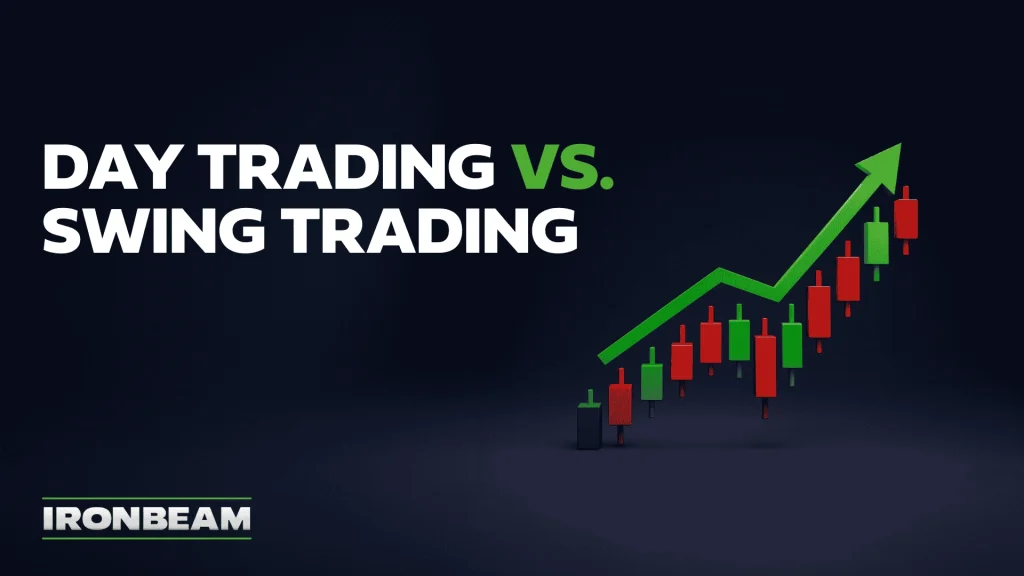Day Trading vs. Swing Trading Futures: Which Fits the Strategy Best?

Quick take
Day trading focuses on opening and closing futures positions within the same session to avoid overnight exposure and capture intraday moves, often using lower day trade margins and faster execution workflows.
Swing trading holds positions for several days to weeks to target larger trend moves, accepting overnight risk in exchange for fewer trades and more flexible screen time.
What is Day Trading?
Day trading in futures means flattening positions by session end, emphasizing liquidity, speed, and discipline over short holding periods. This approach leverages futures markets and tools like chart trading to execute quickly.
Lower day trade margins can make intraday exposure more capital efficient, especially in active contracts like E-mini and Micro futures where tight spreads support scalping and momentum tactics. Day trading is very popular in the futures market due to the lack of PDT rules and low margin requirements.
What is Swing Trading?
Swing trading targets multi-day price swings by aligning with higher timeframe trends and technical structures, often using daily and hourly charts. Position sizing must account for larger stop distances and the possibility of gaps.
Because positions are held overnight, traders should plan for margin differences between day and overnight, and manage news risk around economic releases and earnings-linked sector moves.
Key Differences
Time commitment: Day trading demands sustained focus during market hours; swing trading allows more flexibility with periodic check-ins.
Risk profile: Day traders eliminate overnight risk but face intraday volatility; swing traders accept gap risk for the chance to capture broader trend moves.
Trade frequency and costs: Day trading often involves more contracts traded and potential fees; swing trading reduces frequency but may require wider stops and patience.
Margin and Leverage Considerations
Futures use margin and leverage, allowing control of larger notional value with smaller capital, which magnifies both gains and losses. Risk management and right-sizing positions are essential across both styles.
Day trade margins can be materially lower than overnight requirements, so strategies should be planned around careful risk management, as your gains and losses can be amplified by taking advantage of the higher leverage offered on day trade margins.
Strategy Examples
Day trading tactics: momentum breakouts around the open, range rotations in liquid micro contracts, and event-driven plays around scheduled economic data.
Swing trading tactics: pullback entries in established trends, multi-day range breaks, and mean reversion into higher timeframe levels with defined risk.
Tools and Workflow with Ironbeam
The Ironbeam platform offers chart trading, order strategy templates, and synchronized desktop, web, and mobile access, supporting rapid order entry for intraday traders and monitoring for swing traders.
Competitive day trade margins and integrated market data make it straightforward to test either approach in popular contracts, including micros for capital efficiency.
Choosing a Path
Choose day trading if rapid decisions, structured routines, and intraday execution fit your trading temperament and schedule.
Choose swing trading if flexibility, patience with overnight holds, and a focus on broader trends match your objectives and risk tolerance.
Getting Started at Ironbeam
Begin with a defined plan, clear entry/exit rules, and risk parameters, then use the platform’s chart trading, alerts, and margin tools to execute consistently.
For capital efficiency while learning, consider micro contracts and monitor day trade versus overnight margin impacts as the approach evolves.
Start Trading Smarter.
Open your Ironbeam futures account and access the markets with confidence – on your terms.
RISK DISCLAIMER: There is a substantial risk of loss in trading commodity futures and options. Past performance is not necessarily indicative of future results. Only risk capital should be used. Losses from commodity investments may be greater than the initial investment(s). Commodity trading is not appropriate for all investors, and a commodity investment must be evaluated in light of the potential for risk of loss as well as the possibility of profit.
